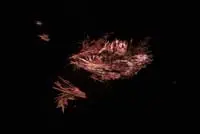 A team from the Technical University of Munich (TUM) has discovered a double helix structure in an inorganic material. The material, called SnIP, comprising tin, iodine and phosphorus, is a semiconductor said to possess extraordinary optical and electronic properties and, unlike conventional inorganic semiconducting materials, it is highly flexible.
A team from the Technical University of Munich (TUM) has discovered a double helix structure in an inorganic material. The material, called SnIP, comprising tin, iodine and phosphorus, is a semiconductor said to possess extraordinary optical and electronic properties and, unlike conventional inorganic semiconducting materials, it is highly flexible.
“These properties of SnIP are clearly attributable to the double helix,” said TUM researcher Daniela Pfister. “SnIP can be produced on a gram scale and is, unlike gallium arsenide which has similar electronic characteristics, far less toxic.”
“We have, alongside the 3D semiconducting material silicon and the 2D material phosphorene, for the first time a one dimensional material,” said TUM Professor Nilges.
Theoretical calculations by the researchers have shown that a whole range of further elements should form these kinds of inorganic double helices.
“Compared to organic solar cells, we hope to achieve higher stability from the inorganic materials. For example, SnIP remains stable up to around 500°C,” Professor Nilges explained.
Since the double helix strands of SnIP come in left and right-handed variants, materials that comprise only one of the two should supposedly display special optical characteristics. So far, however, there is no technology available for separating the two variants.
Just as with carbon nanotubes and polymer-based printing inks, SnIP double helices can be suspended in solvents like toluene. In this way, thin layers could be produced easily and cost-effectively.
The semiconducting properties of SnIP promise a wide range of application opportunities, from energy conversion in solar cells and thermoelectric elements to photocatalysts, sensors and optoelectronic elements. The fibres can be split into thinner strands only a few nanometres thick, which suggests it could also be used for nanoelectronic applications.
Author
Peggy Lee
Source: www.newelectronics.co.uk

